MAN SE
MAN SE
Jump to navigation
Jump to search
 | |
Type | Societas Europaea |
|---|---|
| Traded as | FWB: MAN |
| Industry | Manufacturing, automotive industry, marine engineering |
| Founded | 1758 (1758)[1] |
| Headquarters | Munich, Germany |
Key people | Joachim Drees (CEO) Andreas Renschler (Chairman of the Supervisory Board) |
| Products | Commercial vehicles, diesel and other engines, turbomachinery |
| Revenue | €13.6 billion (2016)[2] |
| Owner | Volkswagen Group (75.73%)[3] |
Number of employees | 53,824 (end 2016)[4] |
| Website | corporate.man.eu/en/index.html |
MAN SE (German: [ɛmʔaːʔˈɛn ʔɛsˈʔeː]; abbreviation of Maschinenfabrik Augsburg-Nürnberg, German: [maˈʃiːnənfaˈbʁiːk ˈʔaʊ̯ksbʊɐ̯k ˈnʏɐ̯nbɛɐ̯k, -faˈbʁɪk]), formerly MAN AG (German: [ˈman ʔaːˈgeː]), is a German mechanical engineering company and parent company of the MAN Group. It is a subsidiary of automaker Volkswagen AG.[5] MAN SE is based in Munich. Its primary output is for the automotive industry, particularly heavy trucks. Further activities include the production of diesel engines for various applications, like marine propulsion, and also turbomachinery.[6]
MAN supplies trucks, buses, diesel engines and turbomachinery.[6] In 2016, its 53,824 employees generated annual sales of around €13.6 billion.
Contents
1 Corporate overview
2 History
2.1 Foundation
2.2 Crisis and World War II
2.3 Postwar period
2.4 Takeover by Volkswagen
3 See also
4 References
5 External links
Corporate overview[edit]
MAN SE is owned in majority by Volkswagen AG. It currently operates its production output through two main business areas:
Commercial Vehicles, comprising MAN Truck & Bus and MAN Latin America and participation in the manufacturers MAN Force Trucks (India) and Sinotruk (China).[7]
Power Engineering, featuring MAN Diesel & Turbo and Renk.[8]
History[edit]
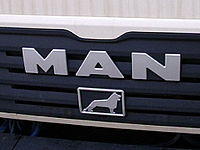
This logo is on the front of all MAN trucks and buses. The lion comes from Büssing AG, a company that MAN acquired in 1971. It resembles the coat of arms of the city of Brunswick.
 Play media
Play mediaMAN fire engine
Foundation[edit]
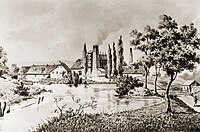
St. Antony
MAN traces its origins back to 1758, when the "St. Antony" ironworks commenced operation in Oberhausen, as the first heavy-industry enterprise in the Ruhr region. In 1808, the three ironworks "St. Antony", "Gute Hoffnung" (English: "Good Hope"), and "Neue Essen" (English: "New Forges") merged, to form the Hüttengewerkschaft und Handlung Jacobi (English: "Jacobi Iron And Steel Works Union And Trading Company"), Oberhausen, which was later renamed Gute Hoffnungshütte (GHH).[1]
In 1840, the German engineer Ludwig Sander founded in Augsburg the first predecessing enterprise of MAN in Southern Germany: the "Sander'sche Maschinenfabrik." It firstly became the "C. Reichenbach'sche Maschinenfabrik", which was named after the pioneer of printing machines Carl August Reichenbach, and later on the "Maschinenfabrik Augsburg".[1]
The branch Süddeutsche Brückenbau A.G. (MAN-Werk Gustavsburg) was founded when the company in 1859 was awarded the contract for the construction of the railway bridge over the Rhine at Mainz.
In 1898, the companies Maschinenbau-AG Nürnberg (founded 1841) and Maschinenfabrik Augsburg AG (founded 1840) merged to form Vereinigte Maschinenfabrik Augsburg und Maschinenbaugesellschaft Nürnberg A.G., Augsburg ("United Machine Works Augsburg and Nuremberg Ltd."). In 1908, the company was renamed Maschinenfabrik Augsburg Nürnberg AG, or in short, M·A·N.
While the focus initially remained on ore mining and iron production in the Ruhr region, mechanical engineering became the dominating branch of business in Augsburg and Nuremberg. Under the direction of Heinrich von Buz, Maschinenfabrik Augsburg grew from a medium-sized business of 400 employees into a major enterprise with a workforce of 12,000 by the year 1913.
Locomotion, propulsion and steel building were the big topics of this phase. The early predecessors of MAN were responsible for numerous technological innovations. The success of the early MAN entrepreneurs and engineers like Heinrich Gottfried Gerber, was based on a great openness towards new technologies. They constructed the Wuppertal monorail ("Wuppertaler Schwebebahn") and the first spectacular steel bridges like the Großhesseloher Brücke in Munich in 1857 and the Müngsten railway bridge between 1893 and 1897.

Suspension railway in Wuppertal, Germany, construction MAN-Werk Gustavsburg
The invention of the rotary printing press allowed the copious printing of books and newspapers and since 1893, Rudolf Diesel puzzled for four years with future MAN engineers in a laboratory in Augsburg until his first Diesel engine was completed and fully functional.
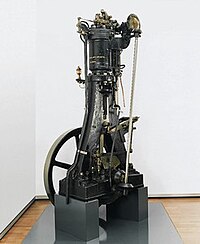
Rudolf Diesel's first engine.
During 1921, the majority of M.A.N. was taken over by the Gutehoffnungshütte Actienverein für Bergbau und Hüttenbetrieb, Sterkrade (GHH), (founded 1873).[1]
Through well-directed equities and acquisitions of processing industries, e.g., Deutsche Werft (1918), Ferrostaal (1921), Deggendorfer Werft und Eisenbau (1924), MAN advanced to a nationwide operating enterprise, with a workforce of 52,000 by 1921.
Crisis and World War II[edit]
At the same time the GHH's economic situation worsened. The causes for this were, among others, the reparations after World War I, the occupation of the Ruhr region and the world economic crisis. In only two years the number of MAN employees sank from 14,000 in the year 1929/30 to 7,400 in 1931/32. While the civil business was largely collapsing, the military business increased with the armament under the National Socialist regime. GHH/MAN enterprises supplied diesel engines for submarines, tanks (Panzers), cylinders for projectiles and artillery of every description. MAN also produced gun parts, including Mauser Karabiner 98k rifle bolts. Their Waffenamt code was WaA53, and ordnance code was "coc".
The MAN works in Augsburg, which produced diesel engines for U-boats, and the MAN works in Nuremberg, which built 40 percent of Germany's Panther tanks, were often the target of massive Allied bombing attacks during World War II.[1]
Postwar period[edit]
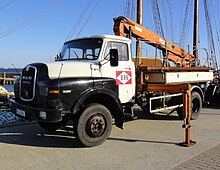
MAN truck 11-136
After the end of World War II the allies split up the GHH group. A vertical integration in which mining, iron and steel production are consolidated was not allowed any more. The "Gutehoffnungshütte", together with the MAN firms of Southern Germany, therefore concentrated on engineering, plant construction, commercial vehicles and printing machines.
This process has been supported by strategic acquisitions and dispositions; one of the most important was the take-over of the truck and bus division of the commercial vehicles manufacturer Büssing (1971), the disposition of the shares of the shipyard Deutsche Werft (1966/67) and the acquisition of the printing machine producer Faber&Schleicher as well as its fusion to MAN Roland Druckmaschinen AG (1979).[1]
In 1982/83 the "Gutehoffnungshütte" plunged into a deep corporate crisis. The enterprise suffered from the late effects of the second oil crisis and a bad economic situation. This was particularly displayed by the dramatic downturn of the commercial vehicles sales figures. Besides external factors, the chief course of these problems was the obsolete company structure with extensive cross-subsidisation between the divisions. At this time the former director of GHH presented a reclamation concept that envisioned a complete consolidation of the subsidiary with the holding company. This concept encountered great resistance with GHH's major shareholders Allianz AG and Commerzbank. The media speculated about a "Bavarian conspiracy" against the Management in Oberhausen.[1]
In 1986, with Klaus Götte, the group got a new company structure and became a contractual group with economically independent division at several locations. This was also attended by the transferring of the MAN headquarters from Oberhausen to Munich and by the new company name MAN AG.

Volkswagen Caminhões e Ônibus Constellation truck
Rudolf Rupprecht repelled a takeover attempt in 2003. Furthermore, the disposition of the 50-percent share of the SMS Group and the strengthening of the turbomachinery division through the takeover of Sulzer Turbo induced MAN's focusing process.
In 2006, MAN entered into an agreement with Indian company Force Motors to establish a 50:50 joint venture for the production of trucks and buses in India for the domestic and export markets. The joint-venture established a truck manufacturing plant in Pithampur, Madhya Pradesh and launched its first truck for the Indian market in 2007. At the end of 2011, MAN bought out the stake of its Indian partner, and its operations in India became a wholly owned subsidiary of MAN in early 2012.[9][10]
In September 2006, MAN produced an offer for the take-over of the Swedish competitor Scania AB. The European Commission approved the takeover on 14 December. Nevertheless, MAN voluntarily withdrew the offer on 23 January 2007, after Scania's major shareholders Volkswagen AG and the influential Wallenberg family had declined the offer. On 24 December 2008, MAN published to possess further stock options of Scania and to therefore maintain more than 20 percent of the voting rights.

2016 MAN TGS 26.480 6X4 BL (30S) truck.
In 2008, the MAN group celebrated its 250th anniversary with numerous events, like exhibitions in several museums, a vintage car tour with the motto "MAN on the road again" and a great anniversary gala. At the beginning of December 2008 MAN took over Volkswagen's Brazilian truck and bus operation, Volkswagen Caminhões e Ônibus, putting the division under the control of MAN Latin America. Therewith, MAN now is market leader in Brazil, with a market share of 30 percent.
Since May 2009, the group is incorporated as European corporation MAN SE.[11] In July 2009 MAN published to merge the two divisions MAN Turbo and MAN Diesel into one business area called Power Engineering. In addition the group contracted a strategic partnership with the Chinese truck manufacturer Sinotruk.
In the course of this focusing process many smaller subsidiaries and division have been sold.
In 2009, investigators of the Munich Prosecutor's Office uncovered a corruption affair, in which MAN had been bribing business partners and governments in over 20 countries during the years 2001 to 2007, in order to get large orders for buses and trucks. MAN CEO Håkan Samuelsson and further board members had to resign. The board of directors appointed Dr.-Ing. Georg Pachta-Reyhofen, the former CEO of MAN Diesel, as successor. On 17 December 2009 Pachta-Reyhofen was assigned as speaker of the board and CEO of MAN SE by the board of directors.
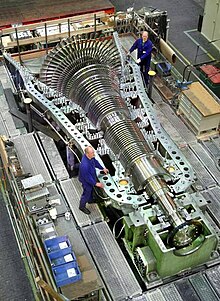
MAN steam turbine
Takeover by Volkswagen[edit]
In July 2011, Volkswagen AG acquired a 55.9% voting stake and 53.7% of the share capital in MAN SE. Pending regulatory approval, Volkswagen planned to merge MAN and Scania to create Europe's largest truckmaker. The combined trucks group is planned to save about 400 million euros per year, mainly by bundling procurement.[12][13] Regulatory approval was granted, and the takeover completed, in November 2011.[14]
In April 2012 MAN SE announced that Volkswagen had increased its interest to a 73.0% voting stake and 71.08% of the share capital.[15]
On 6 June 2012 Volkswagen AG announced that it had increased its share of voting rights in MAN SE to 75.03%, paving the way for a domination agreement to be put in place.[16]
See also[edit]
- ÖAF
- ERF
- Gräf & Stift
- MAN Diesel
- Voith
- Volkswagen Caminhões e Ônibus
- ZF Friedrichshafen
References[edit]
^ abcdefg "MAN SE - The MAN Group's History - Industrial Pioneering". MAN SE. MAN.de. Retrieved 23 November 2009..mw-parser-output cite.citationfont-style:inherit.mw-parser-output qquotes:"""""""'""'".mw-parser-output code.cs1-codecolor:inherit;background:inherit;border:inherit;padding:inherit.mw-parser-output .cs1-lock-free abackground:url("//upload.wikimedia.org/wikipedia/commons/thumb/6/65/Lock-green.svg/9px-Lock-green.svg.png")no-repeat;background-position:right .1em center.mw-parser-output .cs1-lock-limited a,.mw-parser-output .cs1-lock-registration abackground:url("//upload.wikimedia.org/wikipedia/commons/thumb/d/d6/Lock-gray-alt-2.svg/9px-Lock-gray-alt-2.svg.png")no-repeat;background-position:right .1em center.mw-parser-output .cs1-lock-subscription abackground:url("//upload.wikimedia.org/wikipedia/commons/thumb/a/aa/Lock-red-alt-2.svg/9px-Lock-red-alt-2.svg.png")no-repeat;background-position:right .1em center.mw-parser-output .cs1-subscription,.mw-parser-output .cs1-registrationcolor:#555.mw-parser-output .cs1-subscription span,.mw-parser-output .cs1-registration spanborder-bottom:1px dotted;cursor:help.mw-parser-output .cs1-hidden-errordisplay:none;font-size:100%.mw-parser-output .cs1-visible-errorfont-size:100%.mw-parser-output .cs1-subscription,.mw-parser-output .cs1-registration,.mw-parser-output .cs1-formatfont-size:95%.mw-parser-output .cs1-kern-left,.mw-parser-output .cs1-kern-wl-leftpadding-left:0.2em.mw-parser-output .cs1-kern-right,.mw-parser-output .cs1-kern-wl-rightpadding-right:0.2em
^ "Annual Report 2010" (PDF). MAN Group. Archived from the original (PDF) on 12 August 2011. Retrieved 3 April 2011.
^ http://www.4-traders.com/MAN-SE-436151/company/. Retrieved 25 October 2016. Missing or empty|title=(help)
^ "MAN SE Annual Report 2013" (PDF). Man Group. April 2013. Retrieved 28 April 2015.
^ MAN AG Annual Report 2016. MAN AG. 2016. p. https://www.corporate.man.eu/man/media/en/content_medien/doc/global_corporate_website_1/investor_relations_1/gb/2016_40/GB2016_DEU_geschutzt.pdf.
^ ab "MAN AT A GLANCE". MAN SE. MAN.de.
^ "MAN Global Corporate Website". www.man.eu. MAN SE. 12 January 2014. Retrieved 12 January 2014.
^ MAN. "Company structure of MAN | MAN SE". Retrieved 1 August 2017.
^ "Annual Press Conference - February 14, 2012" (PDF). MAN SE. Retrieved 22 February 2012.
[permanent dead link]
^ "Ten years of MAN Truck & Bus in India". PressCenter. MAN SE. 16 September 2016. Archived from the original on 17 October 2016.
^ "MAN becomes a European stock corporation". www.man.eu. MAN SE. 26 May 2009. Archived from the original on 20 July 2011. Retrieved 17 December 2009.
^ "VW motors ahead with MAN-Scania truck merger plan". Reuters. 31 May 2011. Retrieved 16 August 2011.
^ "VW Moves on Trucks". Wall Street Journal. 5 July 2011. Retrieved 16 August 2011.
^ "VW Claims Victory". Commercial Motor. 27 November 2011. Retrieved 28 November 2011.
^ "Volkswagen hikes majority stake in truckmaker MAN". 13 April 2012. Retrieved 10 May 2012.
^ "Volkswagen Group increases its share of voting rights in MAN SE to 75.03 percent". 6 June 2012. Retrieved 6 June 2012.
External links[edit]
| Wikimedia Commons has media related to MAN AG. |
- Official website
Documents and clippings about MAN SE in the 20th Century Press Archives of the German National Library of Economics (ZBW)
Categories:
- MAN SE
- 1758 establishments in Germany
- Bus manufacturers
- Defence companies of Germany
- Military vehicle manufacturers
- German brands
- Motor vehicle manufacturers of Germany
- Companies listed on the Frankfurt Stock Exchange
- Emergency services equipment makers
- Diesel engine manufacturers
- Truck manufacturers
- Volkswagen Group
- Societates Europaeae
(window.RLQ=window.RLQ||).push(function()mw.config.set("wgPageParseReport":"limitreport":"cputime":"0.600","walltime":"0.792","ppvisitednodes":"value":2395,"limit":1000000,"ppgeneratednodes":"value":0,"limit":1500000,"postexpandincludesize":"value":130464,"limit":2097152,"templateargumentsize":"value":3391,"limit":2097152,"expansiondepth":"value":12,"limit":40,"expensivefunctioncount":"value":4,"limit":500,"unstrip-depth":"value":1,"limit":20,"unstrip-size":"value":43291,"limit":5000000,"entityaccesscount":"value":1,"limit":400,"timingprofile":["100.00% 583.674 1 -total"," 40.31% 235.277 1 Template:Reflist"," 22.83% 133.235 12 Template:Cite_web"," 16.87% 98.454 1 Template:Infobox_company"," 13.81% 80.578 1 Template:Infobox"," 11.25% 65.656 8 Template:Navbox"," 8.26% 48.212 1 Template:Dead_link"," 8.02% 46.815 1 Template:Official_website"," 7.51% 43.807 1 Template:Fix"," 7.18% 41.898 2 Template:Redirect"],"scribunto":"limitreport-timeusage":"value":"0.250","limit":"10.000","limitreport-memusage":"value":5412867,"limit":52428800,"cachereport":"origin":"mw1273","timestamp":"20181109175424","ttl":86400,"transientcontent":true);mw.config.set("wgBackendResponseTime":95,"wgHostname":"mw1329"););

 Clash Royale CLAN TAG
Clash Royale CLAN TAG